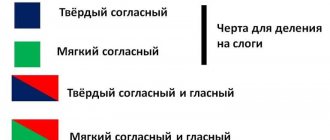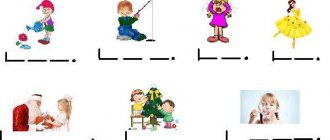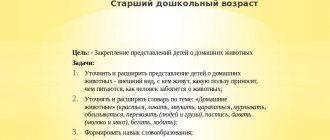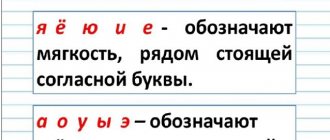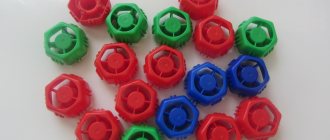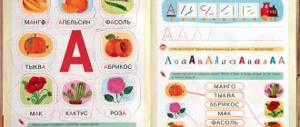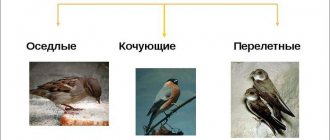How many sounds are there in Russian?
Despite the fact that the Russian alphabet is represented by 33 letters, there are 42 sounds in the Russian alphabet . Among them are vowels (there are only six) and consonants (there are many more - 36).
During the sound-letter analysis of a word, one should clearly distinguish what letters and sounds are. A letter is, in other words, a hieroglyph that is seen and used in written speech, and a sound is pronounced and heard by people.
Vowel sounds and letters
What is a vowel sound? How many vowel sounds and vowel letters are there in the Russian language? What vowel letters can represent two sounds? What are the different vowel sounds? How to find out how many syllables there are in a word?
1. The vowel sound consists only of the voice. When pronouncing vowel sounds, the air stream does not encounter any obstacles. There are 6 vowel sounds in the Russian language : [a], [o], [u], [i], [s], [e].
| VOWEL SOUNDS | |||||
| [A] | [O] | [y] | [And] | [s] | [e] |
2. In writing, vowel sounds are indicated by letters. There are 10 vowels in total . The letters A, O, U, Y, E indicate the hardness of the previous consonant sounds, and the letters Ya, E, Yu, I, E indicate the softness of the consonant sounds.
| VOWELS | |
| A O U Y E | I am Yo Yu and E |
| indicate the hardness of consonant sounds | indicate the softness of consonant sounds |
| March [March] bag [bag] | mint [m❜áta] hatches [l❜uk❜i] |
3. The vowel letters Ya, Yo, Yu, E indicate TWO sounds (consonant sound [й❜] + vowel sound) in the following cases:
- at the beginning of the word: spruce [y❜el❜], hedgehog [y❜osh], yula [y❜ula]
- after the dividing soft and hard signs b and b: blizzard [v❜й❜уа́ка], ate [сй❜е́ла]
- after a vowel: lighthouse [may❜ak], sing [pay❜ut]
| VOWEL LETTERS THAT DEnote TWO SOUNDS | |||
| I [y❜a] | Yo [y❜o] | Yu [y❜y] | E [y❜e] |
4. Vowel sounds can be stressed or unstressed .
One of the syllables in a word is usually pronounced with greater force and duration in the voice. This means that the emphasis falls on it. Such a syllable is called stressed. The vowel sound in this syllable is also called stressed. The remaining syllables in the word are called unstressed .
All 6 vowel sounds are distinguished under stress, i.e. what is pronounced is what is written: water [water], bear [m❜ishka].
In the unstressed position, not all vowel sounds are distinguished. For example, in the word water, instead of [o], it is pronounced [a]: water [vada].
5. Words are divided into syllables . A syllable is one sound or several sounds pronounced by one exhalation push of air. For example: mo-lo-ko, sta-kan, na-u-ka.
In the Russian language there are sounds of different audibility: vowel sounds are more sonorous compared to consonant sounds.
It is vowel sounds that form syllables and are syllabic.
Consonant sounds are non-syllabic. When pronouncing a word, the consonant sounds “stretch” towards the vowels, forming a syllable together with the vowels.
There are as many syllables in a word as there are vowel sounds!
►
Stressed unstressed vowel sounds
All sounds in the Russian alphabet are divided into vowels and consonants. When combined with each other, they form syllables, and syllables form words. Each word contains the most important dominant syllable - this is the stressed syllable. In the stressed position, the vowel sound is always stressed, and all other vowels are unstressed. Stressed vowels are always in a strong position.
Presentation for an alphabet lesson in 1st grade. Vowels and consonants.
Explanatory note
Author of the development
: Kadyrova Olga Igorevna, primary school teacher, MAOU secondary school No. 52, Tyumen
UMK:
"School of Russia"
Class:
1a
Item
: ABC (learning to read and write)
Lesson topic:
Vowels and consonants
Lesson type:
Lesson for the initial presentation of new knowledge.
Lesson duration:
35 minutes
The target audience:
1st grade students, the audience is psychologically homogeneous, the level of development is average.
Textbook:
V.G. Goretsky, V.A. Kiryushkin, part 1, M.: Education, 2017.
Chapter:
pre-literate period, the curriculum provides 4 hours per week, 132 hours per year.
Author's media product:
presentation on the topic
Necessary technical means and materials for conducting the lesson:
Multimedia projector, computer, screen, counting sticks for making word diagrams, a regular notebook in a square alphabet
Methods and techniques:
reproductive, interactive, problematic, dialogical, playful, research
.
Student activities:
frontal, steam room, individual survey
.
Technologies:
ICT, person-oriented, health-saving.
Subject UUD:
Use the terms “speech”, “sentence”, “word”, “syllable”, “stress”, “sound”, “vowel”, “consonant”, “merging syllable”.
Model proposals, record them in a diagram; determine the order of words in a sentence. Divide words into syllables; determine the number of syllables in a word; highlight the stressed syllable; highlight merging syllables and sounds outside the merging in words. Establish the number, sequence of sounds and the nature of their connection in syllables (merging, non-merging) and in the word as a whole; model words and syllables using diagrams. Meta-subject UUD:
Perceive an educational task, choose a sequence of actions, evaluate the progress and result of implementation. Construct logical reasoning, draw analogies, use generalized methods of action. Master monologue and dialogic forms of speech.
Personal UUD:
Accept and master the social role of the student, realize the personal meaning of the teaching.
Show interest in acquiring and expanding knowledge and methods of action, a creative approach to completing tasks. Understand the reasons for success and failure in your own studies. The pictures used for the presentation are freely available in the Yandex or Google search engines. Lesson 6 Vowels and consonants PPTX / 13.57 MB
Sound frogs. We sing vowel sounds. A. O, U, I, E. MP4 / 573.87 Kb
Hard soft consonants
Linguists divide all consonants into hard and soft. Hardness and softness depend on the vowels following them. Vowels either soften consonants or, on the contrary, make them hard. For this definition, pay attention to the letter behind it. See table below:
Vowel sounds and their brief characteristics. Diphthongs
Before you start analyzing a word, it is important to know what features all phonetic sounds (vowels/consonants) have. When teaching children in the early stages, it is necessary to provide information only about the simplest properties; the child will learn everything else in high school.
Vowel sounds (there are six of them: [o], [a], [e], [s], [u], [i]) can be stressed/unstressed. Also in Russian there are letters that in a certain position can produce a pair of sounds - ё [yo], yu [yu], ya [ya], e [ye].
If they follow consonants, they sound like one sound and add softness to the preceding sound. In other positions (the beginning of a word, after vowels and “ъ” and “ь”) they sound like 2 sounds.
Paired unpaired voiceless consonants, voiced consonants, table
The Cyrillic alphabet of Russian speech is represented by 36 consonant sounds, which in turn are classified by philologists into voiced and voiceless. The voice is involved in the sonority of the sound; if the voice is not present, then the sound is dull.
Vowel sounds
When pronouncing vowel sounds, the air in the mouth passes freely and does not encounter obstacles. They are pronounced only with voice.
There are 6 vowel sounds in Russian:
[a] [o] [i] [s] [y] [e]
and 10 vowel letters that represent vowel sounds:
a, o, y, s, and, e, e, e, yu, i
a o u y e - indicate the hardness of the preceding consonant sound
I ё yu and e - indicate the softness of the preceding consonant sound
Letter ribbon for primary school 1st grade
The ribbon of letters is a teaching guide that serves for clarity in any junior classroom, because it is with it that first-graders begin their acquaintance with literacy. Printed letters in the form of a bright colorful ribbon perfectly illustrate the main principles in phonetics. It introduces children to the alphabet, helps them distinguish consonants from vowels, develops the ability to distinguish letters from each other, and much more. Today, on the shelves of bookstores there are various versions of “Tapes of Letters”. They perfectly complement and transform any school office. You can also easily download them from the Internet and print them. Here are some of the most popular letter variations:
The foundations of any language are laid in infancy; how a child learns them determines his literacy in the future.
